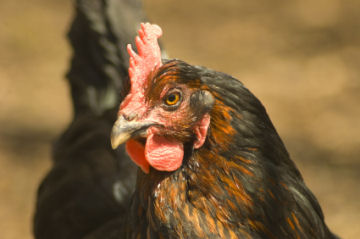Chicken of the Sea
Chickens may have crossed the Pacific Ocean along with early Polynesian explorers.
By Emily Sohn
These days, it’s easy to fly across oceans for vacation. Centuries ago, however, crossing the open seas required planning, handmade boats, and courage.
Scientists and historians have long been looking for clues to explain who crossed which oceans first. When it comes to the trip between Polynesia and South America, chickens may have been among the first ocean voyagers, according to new evidence.
 |
|
This chicken may be a descendant of birds that Polynesian explorers brought to South America. |
| iStockphoto |
After studying an ancient chicken bone, anthropologists from the University of Auckland in New Zealand now say that people (and chickens) traveled from Polynesia to what is now Chile by about 620 years ago. The Inca people were already living in South America by then, but the Polynesians would have been the first to get there by sea. Previous theories claimed that European explorers and their chickens sailed to South America first—but those voyagers didn’t arrive until about a century later.
In 2002, archaeologists dug up 50 chicken bones from a site in Chile called El Arenal. The team from New Zealand analyzed one of these bones. According to their calculations, the bone is about 650 years old.
The researchers also compared the genetic material DNA from the South American chicken bone with DNA from 11 chicken bones that had been found on the Polynesian islands of Tonga and American Samoa. These islands are 6,000 miles west of Chile. The bones found on the Polynesian islands are between 2,000 and 600 years old.
Results of the comparisons showed that the chicken bones from both the Polynesian and South American sites had one stretch of DNA in common. The researchers found the same stretch of DNA in feathers of two living chickens in Chile that belong to a modern breed that lays blue eggs. That DNA evidence suggests a close relationship among the chickens.
“The weight of scientific evidence is now squarely behind the hypothesis that it was seafaring Polynesians who sailed from the islands to South America and returned,” says archaeologist Patrick V. Kirch of the University of California, Berkeley.
In 1989, Kirch found evidence that preserved sweet potatoes came from South America to Polynesia up to 1,000 years ago. The new finding further supports the theory that Polynesians were sailing to South America long before Europeans were.
Other experts disagree with the new historical theory. According to archaeologist Betty Meggers of the Smithsonian Institution’s National Museum of Natural History in Washington, D.C., both a black-boned breed of chickens in Central America and the blue-egg variety in South America came from Asia. Scientists still debate whether the Inca had chickens at all.
Future work is needed to confirm the age of the chicken bones from El Arenal. Only then will we know more about those first brave chicken explorers of the sea.—Emily Sohn
Going Deeper:
Bower, Bruce. 2007. Chicken of the sea: Poultry may have reached Americas via Polynesia. Science News 171(June 9):356. Available at http://www.sciencenews.org/articles/20070609/fob4.asp .
McDonagh, Sorcha. 2003. The puzzle of ancient mariners. Science News for Kids (Oct. 22). Available at http://www.sciencenewsforkids.org/articles/20031022/Note3.asp .
Sohn, Emily. 2006. Chicken talk. Science News for Kids (Nov. 29). Available at http://www.sciencenewsforkids.org/articles/20061129/Note3.asp .







